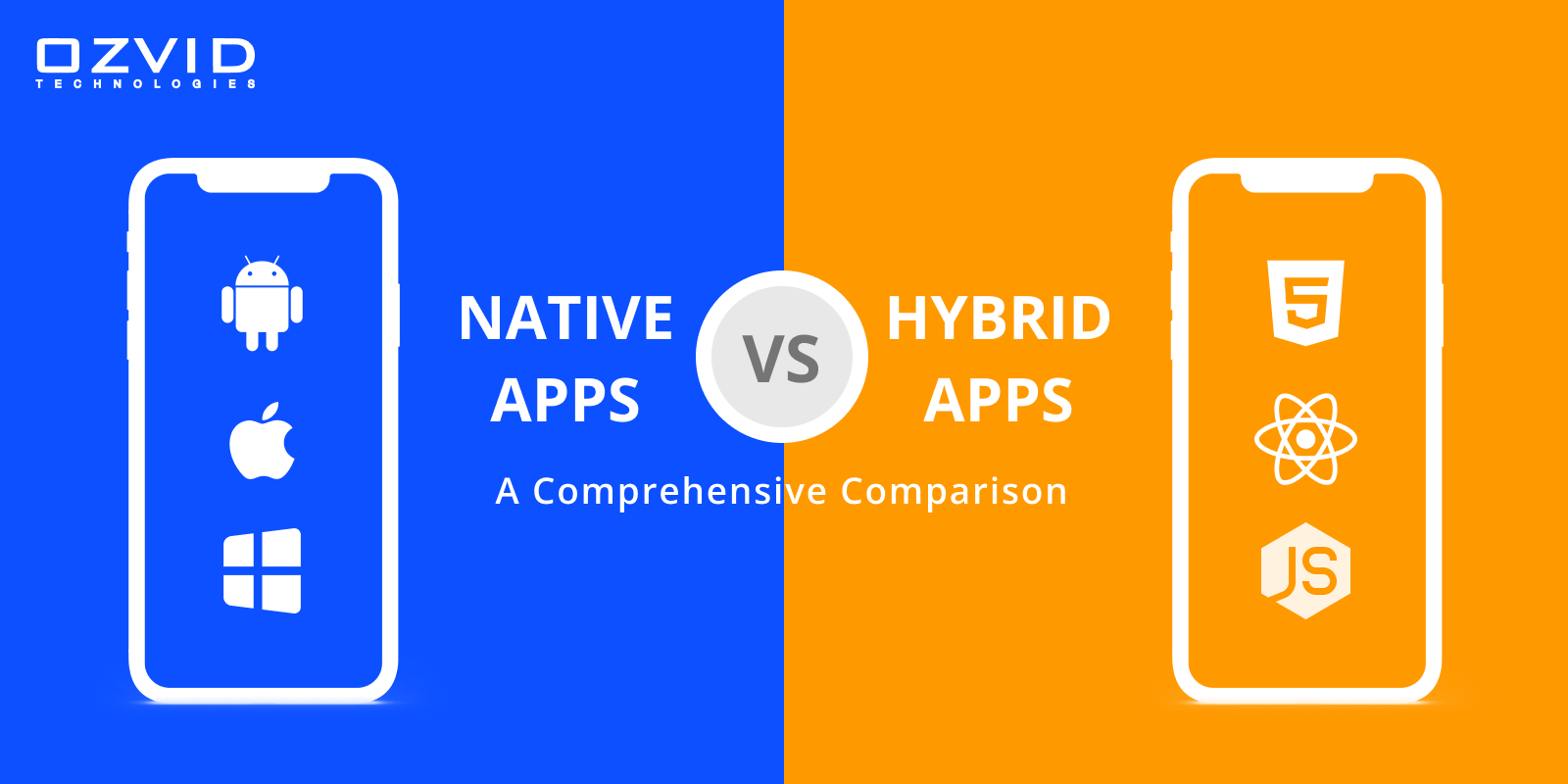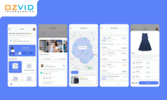- Mar 12, 2024
- Mobile App Development
- 30278
Share this post on:

The mobile app development industry is experiencing rapid growth and is characterized by its dynamic nature. Businesses that choose to invest in mobile app development can anticipate a wide range of benefits, including heightened customer engagement, enhanced productivity, and increased revenue.
The global mobile app market is projected to generate an impressive $935 billion in revenue by 2024. Currently, there are 8.93 million apps available for download worldwide, and consumers spend an average of 4 hours and 48 minutes per day on mobile apps.
Furthermore, businesses are expected to allocate $296 billion towards mobile app development in 2024. The prevalence of mobile phone devices is undeniable, with approximately 84% of the global population now owning smartphones.
In the world of mobile app development, there are two main approaches to creating mobile apps: native apps and hybrid apps. While both types of apps have their own set of advantages and disadvantages, it's essential to understand the differences between them before deciding which approach is best for your business.
In this blog post, we'll provide a detailed comparison of native apps vs hybrid apps, including their benefits, challenges, and the differences between them.
What are Native Apps?
Native apps are mobile applications that are built using the programming languages and frameworks provided by the operating system (OS) for each platform. For example, an iOS app is developed using Swift or Objective-C on Apple devices, while an Android app is developed using Java or Kotlin on Android devices. Native apps are designed to take full advantage of the device's hardware and software capabilities, such as the camera, GPS, and touchscreen display.
Benefits of Native Apps:
Before choosing the native apps for the business, you should know the benefits that native apps offer. Following are a few benefits of native apps for business:
1. Superior User Experience:
Native apps are designed to take full advantage of the unique features and capabilities of each platform, providing a far superior user experience compared to web apps or hybrid apps. For example, native iOS apps can make use of advanced graphics and touchscreen capabilities, while native Android apps can leverage advanced hardware acceleration and larger-screen real estate.
2. Better Performance:
Native apps are typically faster and more responsive than their cross-platform counterparts due to the fact that they are optimized for a specific platform. This means that users will experience fewer bugs, slower load times, and a generally smoother interaction with the app.
3. Integration with Device Hardware:
Native apps can integrate more seamlessly with device hardware features such as GPS, camera, and accelerometer, providing a more immersive user experience. For instance, a native iOS app can utilize the device's gyroscope to provide a more realistic gaming experience or an Android app can use the device's GPS capabilities to provide location-based services.
4. Increased Engagement:
Native apps are designed to take advantage of the unique features of each platform, which can help increase user engagement and loyalty. For example, a native iOS app can make use of push notifications to keep users engaged with the app even when they're not actively using it.
5. Better Security:
Native apps are typically more secure than cross-platform or hybrid apps due to the fact that they are developed specifically for each platform's security standards and best practices. This means that users can rest assured that their personal data will be protected when using native apps.
6. Offline Accessibility:
Many native apps offer offline accessibility, allowing users to continue using the app even when they don't have an internet connection. This is especially useful for businesses that require employees to work in remote locations or areas with limited internet connectivity.
7. Customizable User Interface:
Native apps can be fully customized to match a business's branding and design standards, providing a more professional and polished appearance. This can help establish credibility and trust with users.
8. Improved Analytics and Tracking:
Native apps can provide more detailed analytics and tracking capabilities compared to web or hybrid apps. This can help businesses gain valuable insights into user behavior, which can be used to improve the app's functionality and user experience.
9. Cost-Effective:
Developing a native app for each platform may seem like an expensive endeavor at first glance. However, the long-term benefits of increased engagement, loyalty, and revenue generation make the investment worthwhile. Moreover, many platforms offer development tools and resources to help businesses create high-quality apps with minimal costs.
What are Hybrid Apps?
Hybrid apps are mobile applications that are built using a combination of web technologies such as HTML, CSS, and JavaScript, and then wrapped in a native container. This allows them to be installed and run on a device like a native app, but they are essentially web apps running in a browser shell within the app. Hybrid apps are designed to work across different platforms and can be deployed on both iOS and Android devices. They offer the advantage of being able to access certain device features such as cameras, contacts, and GPS through plugins while still maintaining the ability to use web-based technologies for the core of the application.
Benefits of Hybrid Apps
Knowing the benefits of hybrid apps can help you understand how these apps can benefit your business:
1. Cost-Effectiveness: One of the primary advantages of hybrid apps for businesses is their cost-effectiveness. Developing a single hybrid app that can run on multiple platforms (such as iOS and Android) can be more economical than creating separate native apps for each platform. This approach reduces development costs and time, making it an attractive option for businesses with budget constraints.
2. Cross-Platform Compatibility: Hybrid apps are designed to work across different platforms, allowing businesses to reach a wider audience without the need to develop and maintain separate versions for each platform. This cross-platform compatibility ensures that businesses can engage with users on various devices, including smartphones, tablets, and desktops, without compromising the user experience.
3. Faster Development Time: Building hybrid apps often involves using web technologies such as HTML, CSS, and JavaScript, which are familiar to many developers. As a result, the development process is typically faster compared to creating native apps from scratch. This accelerated development time can be advantageous for businesses looking to launch their apps quickly and stay ahead of the competition.
4. Simplified Maintenance: With hybrid apps, businesses can streamline the maintenance process by updating a single codebase rather than managing multiple codebases for different platforms. This simplification of maintenance tasks can lead to cost savings and more efficient app management, especially when implementing new features or fixing bugs.
5. Access to Device Features: Hybrid apps have access to device features through plugins and APIs, allowing businesses to leverage native device capabilities such as GPS, camera, contacts, and push notifications. This access enables the creation of feature-rich applications that provide a seamless user experience while utilizing the functionalities of the underlying devices.
6. Offline Support: Many hybrid app frameworks offer offline support, allowing users to access certain features or content even when they are not connected to the internet. For businesses operating in areas with limited connectivity or targeting users who may not always have access to a stable network, this offline capability can enhance user engagement and satisfaction.
7. Enhanced User Experience: By combining elements of both web and native applications, hybrid apps can deliver a user experience that closely resembles that of native apps while also offering the flexibility of web technologies. This balance results in an enhanced user experience that meets modern expectations for performance, responsiveness, and visual appeal.
Differences Between Native Apps and Hybrid Apps
Native apps and hybrid apps are two different types of mobile applications, each with its own set of characteristics and advantages. Understanding the differences between these two types of apps can help in making informed decisions when developing a mobile application.
Definition and Characteristics
Native apps are developed specifically for a particular platform or device, such as iOS or Android, using the respective programming languages and development tools. These apps are installed directly onto the device and can access all the features and capabilities of the device, including camera, GPS, contacts, and more. They offer high performance and a seamless user experience due to their integration with the device’s hardware and software.
While, hybrid apps are developed using HTML, CSS, and JavaScript. They are essentially web applications wrapped in a native container that allows them to be installed and run on a device like a native app. Hybrid apps can be deployed across multiple platforms with minimal changes to the codebase, making them cost-effective for businesses targeting multiple platforms. However, they may not offer the same level of performance as native apps.
User Experience
Native apps generally provide a smoother and more responsive user experience compared to hybrid apps. This is because native apps are optimized for the specific platform they are built for, leveraging the platform’s native capabilities and design guidelines. As a result, users often find native apps to be more intuitive and faster in terms of navigation and responsiveness.
Hybrid apps, while capable of delivering a decent user experience, may not match the level of performance and responsiveness offered by native apps. Since they rely on web technologies within a native wrapper, there may be limitations in terms of accessing certain device features or delivering complex animations and transitions.
Development Time and Cost
Developing native apps for multiple platforms requires separate codebases for each platform, which can increase development time and cost. Developers from a native app development company need to write code in different programming languages (Swift or Objective-C for iOS, Java or Kotlin for Android) to target each platform individually.
In contrast, hybrid apps can be developed using a single codebase that can be deployed across multiple platforms. This approach can significantly reduce development time and cost since developers only need to maintain one codebase for all platforms. However, optimizing the app’s performance across different platforms may require additional effort.
Access to Device Features
Native apps have full access to the device’s hardware and software features through platform-specific APIs. This means they can leverage functionalities such as push notifications, camera access, GPS location tracking, and more without significant limitations.
Hybrid apps rely on plugins or third-party tools to access device features beyond what standard web technologies offer. While many plugins exist to bridge this gap, there may still be limitations in accessing certain advanced features or utilizing them to their full potential within a hybrid app.
Offline Capabilities
Native apps have an advantage when it comes to offline capabilities. They can store data locally on the device and function without an internet connection more seamlessly compared to hybrid apps. This is particularly important for applications that require offline access or need to deliver content even when connectivity is limited.
Hybrid apps can also support offline capabilities through caching mechanisms provided by web technologies. However, achieving the same level of offline functionality as native apps may require additional effort in managing data synchronization and handling offline scenarios effectively.
Updates and Maintenance
Native apps typically require separate updates for each platform they support. This means developers need to release updates for iOS and Android versions independently, which can lead to fragmented user experiences if updates are not synchronized across platforms.
Hybrid apps benefit from a single codebase that allows simultaneous updates across all supported platforms. This streamlines the update process and ensures consistency in features and fixes across different devices running the app.
Conclusion: Which One to Choose?
In conclusion, both native apps and hybrid apps have their own strengths and weaknesses. Native apps excel at providing high performance, a seamless user experience, full access to device features, and robust offline capabilities, but require separate development efforts for each platform. On the other hand, hybrid apps offer cost-effective multi-platform deployment, simplified updates across platforms, and faster development cycles but may compromise performance and access to certain device features.
Hence, When deciding between native and hybrid app development, ensure that your desired needs are met. If you are looking to develop high-performing apps to grow your business, look no further than OZVID Technologies. We offer customized app solutions to businesses worldwide, enhancing the visibility of your website. Feel free to contact us.










